Yujia Zhai
FT K-Means: A High-Performance K-Means on GPU with Fault Tolerance
Aug 02, 2024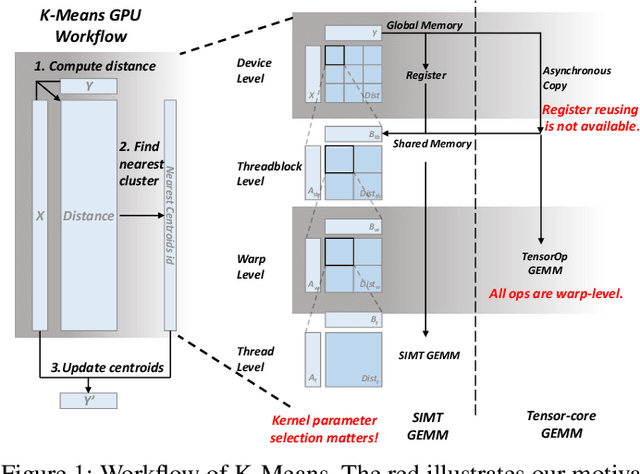
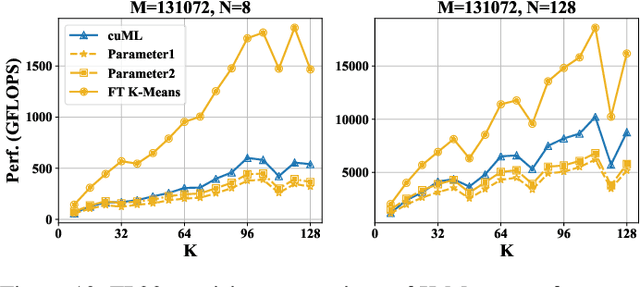
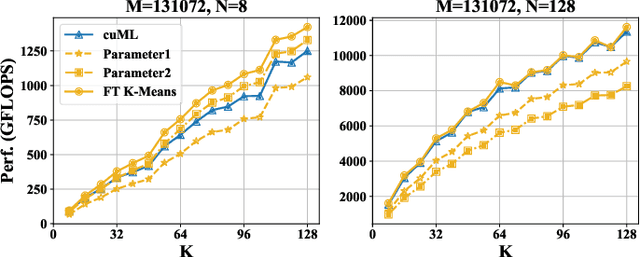
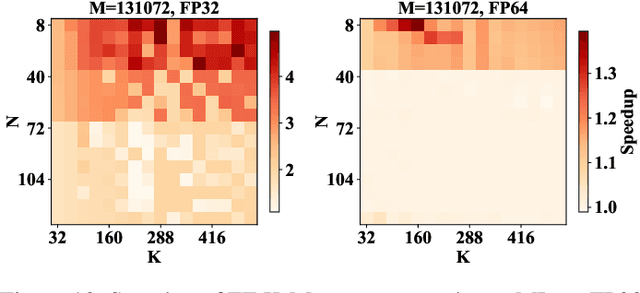
Abstract:K-Means is a widely used algorithm in clustering, however, its efficiency is primarily constrained by the computational cost of distance computing. Existing implementations suffer from suboptimal utilization of computational units and lack resilience against soft errors. To address these challenges, we introduce FT K-Means, a high-performance GPU-accelerated implementation of K-Means with online fault tolerance. We first present a stepwise optimization strategy that achieves competitive performance compared to NVIDIA's cuML library. We further improve FT K-Means with a template-based code generation framework that supports different data types and adapts to different input shapes. A novel warp-level tensor-core error correction scheme is proposed to address the failure of existing fault tolerance methods due to memory asynchronization during copy operations. Our experimental evaluations on NVIDIA T4 GPU and A100 GPU demonstrate that FT K-Means without fault tolerance outperforms cuML's K-Means implementation, showing a performance increase of 10\%-300\% in scenarios involving irregular data shapes. Moreover, the fault tolerance feature of FT K-Means introduces only an overhead of 11\%, maintaining robust performance even with tens of errors injected per second.
ByteTransformer: A High-Performance Transformer Boosted for Variable-Length Inputs
Oct 06, 2022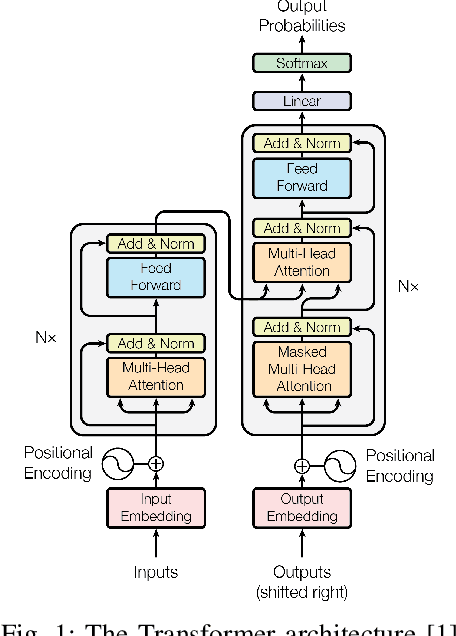
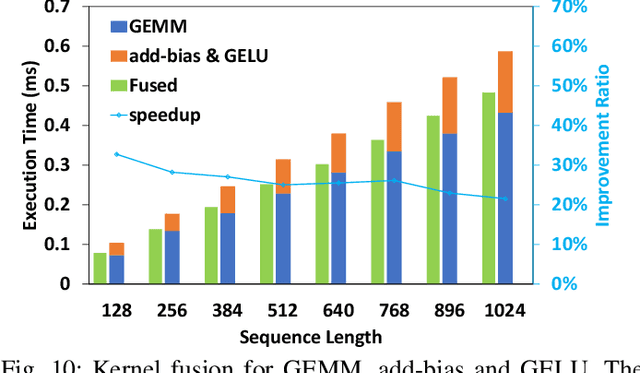
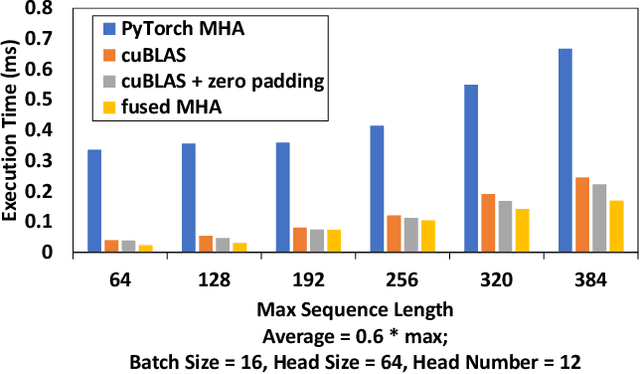
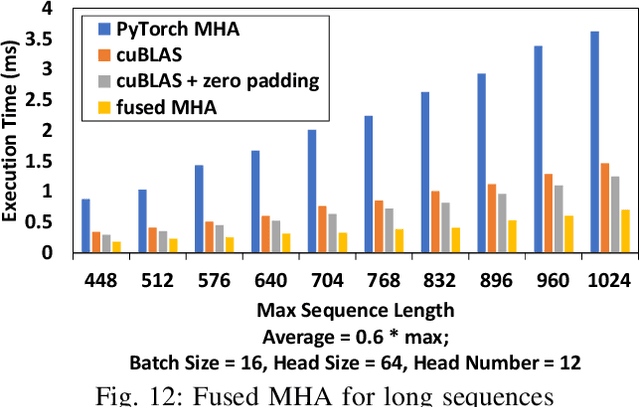
Abstract:Transformer is the cornerstone model of Natural Language Processing (NLP) over the past decade. Despite its great success in Deep Learning (DL) applications, the increasingly growing parameter space required by transformer models boosts the demand on accelerating the performance of transformer models. In addition, NLP problems can commonly be faced with variable-length sequences since their word numbers can vary among sentences. Existing DL frameworks need to pad variable-length sequences to the maximal length, which, however, leads to significant memory and computational overhead. In this paper, we present ByteTransformer, a high-performance transformer boosted for variable-length inputs. We propose a zero padding algorithm that enables the whole transformer to be free from redundant computations on useless padded tokens. Besides the algorithmic level optimization, we provide architectural-aware optimizations for transformer functioning modules, especially the performance-critical algorithm, multi-head attention (MHA). Experimental results on an NVIDIA A100 GPU with variable-length sequence inputs validate that our fused MHA (FMHA) outperforms the standard PyTorch MHA by 6.13X. The end-to-end performance of ByteTransformer for a standard BERT transformer model surpasses the state-of-the-art Transformer frameworks, such as PyTorch JIT, TensorFlow XLA, Tencent TurboTransformer and NVIDIA FasterTransformer, by 87\%, 131\%, 138\% and 46\%, respectively.
Algorithm-Based Fault Tolerance for Convolutional Neural Networks
Mar 27, 2020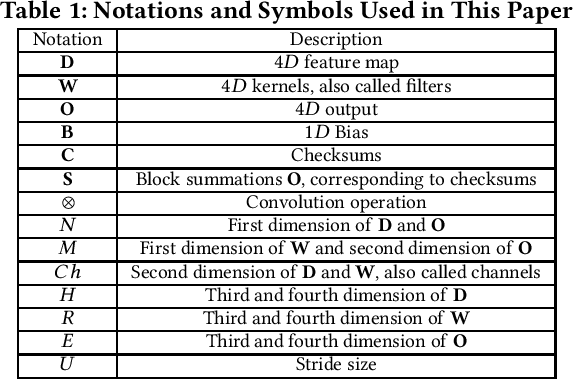
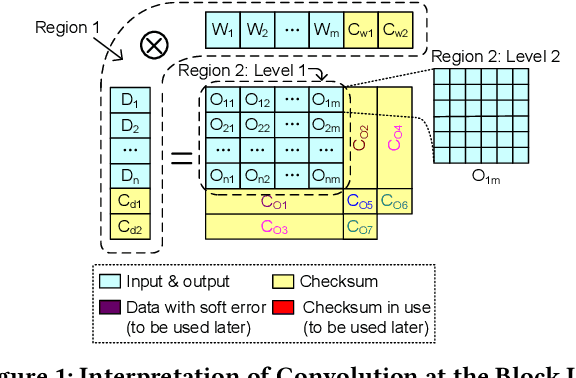

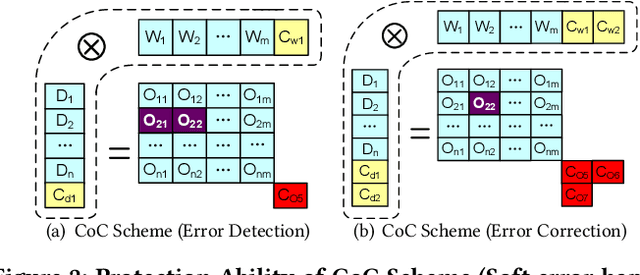
Abstract:Convolutional neural networks (CNNs) are becoming more and more important for solving challenging and critical problems in many fields. CNN inference applications have been deployed in safety-critical systems, which may suffer from soft errors caused by high-energy particles, high temperature, or abnormal voltage. Of critical importance is ensuring the stability of the CNN inference process against soft errors. Traditional fault tolerance methods are not suitable for CNN inference because error-correcting code is unable to protect computational components, instruction duplication techniques incur high overhead, and existing algorithm-based fault tolerance (ABFT) schemes cannot protect all convolution implementations. In this paper, we focus on how to protect the CNN inference process against soft errors as efficiently as possible, with the following three contributions. (1) We propose several systematic ABFT schemes based on checksum techniques and analyze their pros and cons thoroughly. Unlike traditional ABFT based on matrix-matrix multiplication, our schemes support any convolution implementations. (2) We design a novel workflow integrating all the proposed schemes to obtain a high detection/correction ability with limited total runtime overhead. (3) We perform our evaluation using ImageNet with well-known CNN models including AlexNet, VGG-19, ResNet-18, and YOLOv2. Experimental results demonstrate that our implementation can handle soft errors with very limited runtime overhead (4%~8% in both error-free and error-injected situations).
Normalization of Input-output Shared Embeddings in Text Generation Models
Jan 24, 2020



Abstract:Neural Network based models have been state-of-the-art models for various Natural Language Processing tasks, however, the input and output dimension problem in the networks has still not been fully resolved, especially in text generation tasks (e.g. Machine Translation, Text Summarization), in which input and output both have huge sizes of vocabularies. Therefore, input-output embedding weight sharing has been introduced and adopted widely, which remains to be improved. Based on linear algebra and statistical theories, this paper locates the shortcoming of existed input-output embedding weight sharing method, then raises methods for improving input-output weight shared embedding, among which methods of normalization of embedding weight matrices show best performance. These methods are nearly computational cost-free, can get combined with other embedding techniques, and show good effectiveness when applied on state-of-the-art Neural Network models. For Transformer-big models, the normalization techniques can get at best 0.6 BLEU improvement compared to the original version of model on WMT'16 En-De dataset, and similar BLEU improvements on IWSLT 14' datasets. For DynamicConv models, 0.5 BLEU improvement can be attained on WMT'16 En-De dataset, and 0.41 BLEU improvement on IWSLT 14' De-En translation task is achieved.
 Add to Chrome
Add to Chrome Add to Firefox
Add to Firefox Add to Edge
Add to Edge